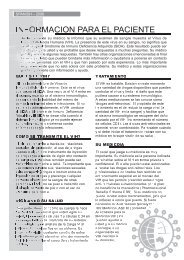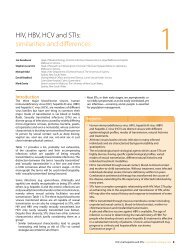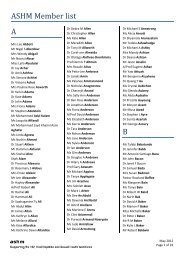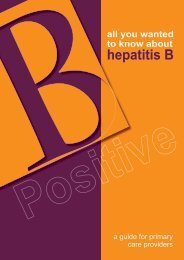Chapter 13 - Standard precautions and infection control - ASHM
Chapter 13 - Standard precautions and infection control - ASHM
Chapter 13 - Standard precautions and infection control - ASHM
You also want an ePaper? Increase the reach of your titles
YUMPU automatically turns print PDFs into web optimized ePapers that Google loves.
<strong>St<strong>and</strong>ard</strong> <strong>precautions</strong> <strong>and</strong><br />
<strong>infection</strong> <strong>control</strong><br />
Jennifer Hoy Infectious Diseases Physician, Alfred Hospital, Melbourne, Victoria.<br />
Jacqui Richmond Victorian Viral Hepatitis Educator, St Vincent's Hospital, Melbourne, Victoria.<br />
The aim of this chapter is to provide:<br />
• Detail about st<strong>and</strong>ard <strong>precautions</strong> <strong>and</strong> <strong>infection</strong><br />
<strong>control</strong> guidelines for health care settings<br />
• Guidance on the management of blood <strong>and</strong> body<br />
substance exposures <strong>and</strong> incidents<br />
Introduction<br />
The potentially infectious nature of all blood <strong>and</strong><br />
body substances necessitates the implementation<br />
of <strong>infection</strong> <strong>control</strong> practices <strong>and</strong> policies. In<br />
Australia, <strong>infection</strong> <strong>control</strong> guidelines have been<br />
developed based on the United States Centers for<br />
Disease Control <strong>and</strong> Prevention model, in terms<br />
of 'st<strong>and</strong>ard <strong>precautions</strong>' <strong>and</strong> transmission based<br />
<strong>precautions</strong>. <strong>St<strong>and</strong>ard</strong> <strong>precautions</strong> ensure a high<br />
level of protection against transmission of bloodborne<br />
viruses in the health care setting <strong>and</strong> the<br />
universal application reduces the potential for<br />
stigma <strong>and</strong> discrimination. <strong>St<strong>and</strong>ard</strong> <strong>precautions</strong><br />
are the minimum level of <strong>infection</strong> <strong>control</strong> required<br />
in the treatment <strong>and</strong> care of all patients to prevent<br />
transmission of blood-borne <strong>infection</strong>s including<br />
HIV, HBV <strong>and</strong> HCV. <strong>St<strong>and</strong>ard</strong> <strong>precautions</strong> should be<br />
implemented universally, regardless of information<br />
or assumptions about a patient's <strong>infection</strong> status.<br />
Additional <strong>precautions</strong> are further measures required<br />
to protect against transmission of <strong>infection</strong>s such as<br />
tuberculosis.<br />
This chapter provides a summary of the most recent<br />
Australian <strong>infection</strong> <strong>control</strong> guidelines endorsed by<br />
the Communicable Diseases Network of Australia<br />
(CDNA), National Public Health Partnership (NPHP)<br />
<strong>and</strong> Australian Health Ministers' Advisory Council<br />
(AHMAC): Infection <strong>control</strong> guidelines for the prevention<br />
of transmission of infectious diseases in the health<br />
care setting 1 . The CDNA guidelines describe in detail<br />
the practices <strong>and</strong> procedures necessary to prevent<br />
transmission of blood-borne <strong>infection</strong>s, including<br />
HIV, HBV <strong>and</strong> HCV. Review of these guidelines is<br />
strongly recommended for clinicians <strong>and</strong> other<br />
health care workers implementing <strong>infection</strong> <strong>control</strong><br />
procedures.<br />
146 HIV, viral hepatitis <strong>and</strong> STIs: STIS: a guide for primary care<br />
Implementation of st<strong>and</strong>ard <strong>precautions</strong> minimises<br />
the risk of transmission of blood-borne <strong>and</strong> other<br />
<strong>infection</strong>s from health care worker to patient,<br />
from patient to health care worker <strong>and</strong> from<br />
patient to patient. Infection <strong>control</strong> guidelines are<br />
relevant in social <strong>and</strong> domestic contexts as well as<br />
occupational settings. The clinician should be ready<br />
to answer patients' questions about their clinic's<br />
<strong>infection</strong> <strong>control</strong> policies <strong>and</strong> provide advice for<br />
patients in relation to <strong>infection</strong> <strong>control</strong> in their daily<br />
environment.<br />
Transmission of blood-borne viruses<br />
The modes of transmission for blood-borne viruses<br />
are outlined in Table <strong>13</strong>.1 <strong>and</strong> risk of transmission<br />
is discussed in more detail in <strong>Chapter</strong>s 2 <strong>and</strong> 3.<br />
Key points<br />
<strong>13</strong><br />
• The potentially infectious nature of all blood <strong>and</strong> body substances<br />
necessitates the implementation of <strong>infection</strong> <strong>control</strong> practices <strong>and</strong><br />
policies in the health care setting.<br />
• The universal application of st<strong>and</strong>ard <strong>precautions</strong> is the minimum<br />
level of <strong>infection</strong> <strong>control</strong> required in the treatment <strong>and</strong> care of<br />
all patients to prevent transmission of HIV, HBV <strong>and</strong> HCV. These<br />
include personal hygiene practices particularly h<strong>and</strong>-washing, use of<br />
personal protective equipment such as gloves, gowns <strong>and</strong> protective<br />
eye wear, aseptic technique, safe disposal systems for sharps <strong>and</strong><br />
contaminated matter, adequate sterilisation of reusable equipment<br />
<strong>and</strong> environmental <strong>control</strong>s.<br />
• Vaccination is an important <strong>infection</strong> <strong>control</strong> strategy for HBV <strong>and</strong><br />
HAV; all health care workers should be aware of their immune status<br />
<strong>and</strong> be vaccinated if appropriate.<br />
• Clinicians <strong>and</strong> other health care workers who regularly perform<br />
exposure-prone procedures have a responsibility to be regularly<br />
tested for HIV, HCV <strong>and</strong> HBV if not immune. Health care workers who<br />
are aware that they are infected with HIV, HBV or HCV should not<br />
perform exposure-prone procedures.<br />
• The current best practice guidelines for <strong>infection</strong> <strong>control</strong> procedures<br />
in Australian health care settings are outlined in Infection Control<br />
Guidelines for the Prevention of Transmission of Infectious Diseases in<br />
the Health Care Setting (2004).
Table <strong>13</strong>.1 Precautions for preventing transmission of blood-borne viruses 1<br />
Disease Mode of transmission Recommended <strong>precautions</strong> Immunisation<br />
HAV Contact (oral-faecal route)<br />
HBV<br />
HCV<br />
HIV<br />
Blood-borne (direct<br />
contact with blood or body<br />
substances)<br />
Blood-borne (direct contact<br />
with blood)<br />
Blood-borne (direct<br />
contact with blood or body<br />
substances)<br />
Transmission of HBV is approximately 100 times more<br />
efficient than transmission of HIV <strong>and</strong> approximately<br />
10 times more efficient than HCV.<br />
The risk of blood-borne virus transmission is<br />
dependent on a number of factors. Incidents involving<br />
blood-to-blood contact with infectious blood are<br />
associated with a high risk of <strong>infection</strong> when:<br />
• There is a large quantity of blood, indicated by<br />
visible contamination<br />
• There is insertion of a needle directly into a vein or<br />
artery or deep cavity<br />
• The patient has advanced HIV disease <strong>and</strong>/or<br />
high HIV viral load; high levels of HBV DNA <strong>and</strong><br />
detectable HBeAg; HCV RNA detected by PCR<br />
Transmission of blood-borne viruses in the health<br />
care setting is generally associated with failure to<br />
comply with recommended <strong>infection</strong> <strong>control</strong><br />
guidelines <strong>and</strong>/or cleaning <strong>and</strong> dis<strong>infection</strong> protocols.<br />
In the case of HCV, patient-to-patient transmission<br />
has been associated with endoscopic procedures,<br />
The risk of transmission of HIV is estimated to be<br />
approximately 0.3% after a percutaneous needlestick<br />
injury with HIV-infected blood <strong>and</strong> 0.09% after a<br />
mucous membrane exposure. Transmission of HBV<br />
in the health care setting can be prevented through<br />
health care worker, patient <strong>and</strong> community hepatitis<br />
B vaccination programs.<br />
<strong>St<strong>and</strong>ard</strong> <strong>precautions</strong><br />
<strong>St<strong>and</strong>ard</strong> <strong>precautions</strong> ensure a high level of<br />
protection against transmission of <strong>infection</strong> including<br />
blood-borne viruses in the health care setting <strong>and</strong><br />
are recommended for the care <strong>and</strong> treatment of all<br />
patients <strong>and</strong> in the h<strong>and</strong>ling of:<br />
• Blood including dried blood<br />
• All other body substances, secretions <strong>and</strong><br />
excretions (excluding sweat) regardless of whether<br />
they contain visible blood<br />
• Non-intact skin<br />
• Mucous membranes.<br />
<strong>St<strong>and</strong>ard</strong> <strong>precautions</strong><br />
Additional <strong>precautions</strong> for<br />
incontinent patients<br />
<strong>St<strong>and</strong>ard</strong> <strong>precautions</strong><br />
Immunise health care workers at<br />
high risk<br />
The universal application of st<strong>and</strong>ard <strong>precautions</strong><br />
is the minimum level of <strong>infection</strong> <strong>control</strong> required<br />
in the treatment <strong>and</strong> care of all patients to prevent<br />
transmission of blood-borne viruses. These include<br />
personal hygiene practices, particularly h<strong>and</strong>washing;<br />
use of personal protective equipment<br />
such as gloves, gowns <strong>and</strong> protective eyewear;<br />
aseptic technique; safe disposal systems for sharps<br />
<strong>and</strong> contaminated matter; adequate sterilisation of<br />
reusable equipment <strong>and</strong> environmental <strong>control</strong>s.<br />
<strong>St<strong>and</strong>ard</strong> <strong>precautions</strong> should be implemented<br />
universally, regardless of information or assumptions<br />
about a patient's blood-borne virus status, <strong>and</strong><br />
therefore assist to reduce potential stigma <strong>and</strong><br />
discrimination in the health care setting.<br />
H<strong>and</strong> hygiene<br />
H<strong>and</strong>-washing is generally considered the most<br />
important hygiene measure in preventing the spread<br />
of <strong>infection</strong>. Clinicians should wash their h<strong>and</strong>s<br />
before <strong>and</strong> after significant contact with any patient<br />
<strong>and</strong> after activities that may cause contamination.<br />
H<strong>and</strong>-washing should occur:<br />
• Before <strong>and</strong> after each clinical contact with a<br />
patient<br />
• Before <strong>and</strong> after eating<br />
• After using the toilet<br />
• Before <strong>and</strong> after using gloves<br />
• After contact with used equipment<br />
• Immediately following contact with body<br />
substances<br />
It is important to note that gloves are not a<br />
substitute for effective h<strong>and</strong>-washing. A routine<br />
h<strong>and</strong>-wash should include removal of jewellery <strong>and</strong><br />
use of a cleaning solution (detergent with or without<br />
disinfectant) <strong>and</strong> water for 15 to 20 seconds, followed<br />
by drying with a single-use towel.<br />
Immunise all health care workers.<br />
Test for seroconversion 4–8 weeks<br />
after 3rd dose of vaccine<br />
<strong>St<strong>and</strong>ard</strong> <strong>precautions</strong> No vaccine available<br />
<strong>St<strong>and</strong>ard</strong> <strong>precautions</strong>.<br />
Additional <strong>precautions</strong> may<br />
be required in the presence of<br />
complicating condition (e.g.<br />
Tuberculosis)<br />
No vaccine available<br />
HIV, viral hepatitis <strong>and</strong> STIs: a guide for primary care 147
<strong>13</strong> <strong>St<strong>and</strong>ard</strong> <strong>precautions</strong> <strong>and</strong> <strong>infection</strong> <strong>control</strong><br />
Skin care is important because healthy, unbroken<br />
skin provides a valuable, natural barrier to <strong>infection</strong>.<br />
Skin breaks should be covered with a water-resistant<br />
occlusive dressing. Alcohol-based h<strong>and</strong> rubs can be<br />
used in the absence of appropriate washing facilities.<br />
Gloves<br />
Gloves are a form of personal protective equipment.<br />
Clinicians <strong>and</strong> other health care workers should wear<br />
gloves whenever there is a risk of exposure to blood<br />
or body substances, <strong>and</strong> should change their gloves<br />
<strong>and</strong> wash their h<strong>and</strong>s after contact with each patient<br />
<strong>and</strong> during procedures with the same patient if there<br />
is a chance of cross contamination. Gloves must be<br />
used when:<br />
• H<strong>and</strong>ling blood <strong>and</strong>/or body substances<br />
• Performing venepuncture<br />
• Touching mucous membranes<br />
• Touching non-intact skin<br />
• H<strong>and</strong>ling contaminated sharps<br />
• Performing invasive procedures<br />
• Cleaning body substances spills or any equipment<br />
(instruments) or materials (linen) or surface that<br />
may have been contaminated by body substances<br />
For further information about the appropriate use<br />
of sterile, non-sterile <strong>and</strong> general purpose gloves<br />
refer to Infection <strong>control</strong> guidelines for the prevention<br />
of transmission of infectious diseases in the health care<br />
setting.<br />
Other personal protective equipment<br />
Personal protective equipment should be readily<br />
available <strong>and</strong> accessible in all health care settings.<br />
The type of protective equipment required depends<br />
on the nature of the procedure, the equipment used<br />
<strong>and</strong> the skill of the operator. For example, the use<br />
of protective equipment is recommended in the<br />
following circumstances:<br />
• Protective eyewear <strong>and</strong> face shields must be worn<br />
during procedures where there is potential for<br />
splashing, splattering or spraying of blood or other<br />
body substances<br />
• Impermeable gowns <strong>and</strong> plastic aprons should<br />
be worn to protect clothing <strong>and</strong> skin from<br />
contamination with blood <strong>and</strong> body substances<br />
• Footwear should be enclosed to protect against<br />
injury or contact with sharp objects<br />
Needlestick or sharps injury prevention<br />
Inappropriate h<strong>and</strong>ling of sharps is a major cause of<br />
accidental exposure to blood-borne viruses in health<br />
care settings. To minimise the risk of a needlestick<br />
or sharps injury, needles, sharps <strong>and</strong> clinical waste<br />
should be h<strong>and</strong>led carefully at all times. Specifically,<br />
clinicians <strong>and</strong> other health care workers should:<br />
• Minimise their h<strong>and</strong>ling of needles, sharps <strong>and</strong><br />
clinical waste<br />
• Not bend or recap needles or remove needles from<br />
disposable syringes<br />
148 HIV, viral hepatitis <strong>and</strong> STIs: STIS: a guide for primary care<br />
• Use safe needle-h<strong>and</strong>ling systems including rigid<br />
containers for disposal, which should be kept out<br />
of the reach of toddlers <strong>and</strong> small children<br />
• Ensure 'sharps' containers are available at the point<br />
of use or in close proximity to work sites to aid<br />
easy <strong>and</strong> immediate disposal<br />
Importantly, the person who has used a sharp<br />
instrument or needle must be responsible for the<br />
immediate <strong>and</strong> safe disposal of the sharp following<br />
its use.<br />
Health care workers<br />
Vaccination<br />
Vaccination is an important <strong>infection</strong> <strong>control</strong><br />
strategy to prevent the transmission of HBV <strong>and</strong> HAV.<br />
The Australian Immunisation H<strong>and</strong>book 2 provides<br />
guidelines on the vaccination of health care workers.<br />
All clinicians <strong>and</strong> other health care workers who may<br />
come into contact with blood or body substances<br />
should be aware of their HBV vaccination status<br />
<strong>and</strong> be vaccinated if appropriate. Post-vaccination<br />
serological testing is recommended four to eight<br />
weeks after completion of the primary course , for<br />
people in the following categories:<br />
• People at significant occupational risk (e.g.<br />
Clinicians <strong>and</strong> other health care workers whose<br />
work involves frequent exposure to blood <strong>and</strong><br />
body substances)<br />
• People at risk of severe or complicated disease (e.g.<br />
people with impaired immunity <strong>and</strong> people with<br />
pre-existing liver disease not related to HBV)<br />
• People in whom a poor response to HBV<br />
vaccination is expected (e.g. patients undergoing<br />
haemodialysis)<br />
• Sexual partners <strong>and</strong> household contacts of people<br />
with hepatitis B<br />
If an individual's anti-HBs level is
Individuals at significant occupational risk who<br />
have a documented history of a primary course of<br />
hepatitis B vaccine, but unknown seroconversion<br />
status, <strong>and</strong> now have an anti-HBs level
<strong>13</strong> <strong>St<strong>and</strong>ard</strong> <strong>precautions</strong> <strong>and</strong> <strong>infection</strong> <strong>control</strong><br />
Post-exposure prophylaxis for HIV in<br />
the health care setting<br />
Post-exposure prophylaxis for HIV is a complex area.<br />
Currently HIV PEP consists of a combination of two to<br />
three drugs depending on the level of risk associated<br />
with the exposure <strong>and</strong> it is recommended that HIV<br />
PEP should be started between one <strong>and</strong> two hours<br />
after an exposure. Post-exposure prophylaxis for HIV<br />
is:<br />
• Recommended for significant percutaneous<br />
exposure to blood or body substances involving a<br />
high risk of HIV transmission<br />
• Offered (but not actively recommended) for ocular<br />
mucous membrane or non-intact skin exposure to<br />
blood or body substances<br />
• Not offered for exposure to any non-bloody urine,<br />
saliva or faeces<br />
Post-exposure prophylaxis for HBV<br />
in the health care setting<br />
If the exposed person is not immune to HBV, or is<br />
unaware of their immune status, then HBIG should be<br />
given within 48–72 hours of exposure. For example:<br />
• If the exposed person is not immune to HBV, or<br />
is of unknown immune status, HBIG should be<br />
administered within 72 hours of exposure<br />
• If the exposed person is a non-responder to the<br />
HBV vaccine, HBIG should be given within 72<br />
hours<br />
There is currently no PEP available to prevent HCV<br />
<strong>infection</strong>.<br />
Infected health care workers<br />
Clinicians <strong>and</strong> other health care workers have a legal<br />
obligation to care for the safety of others in the<br />
workplace, which includes colleagues <strong>and</strong> patients.<br />
Clinicians <strong>and</strong> other health care workers infected<br />
with a blood-borne virus should consult State or<br />
Territory regulations to determine what restrictions<br />
are placed on their clinical practice. In general, it is<br />
recommended they do not perform procedures that<br />
carry a high risk of transmission of the virus from<br />
health care worker to patient, such as exposure-<br />
prone procedures (refer to Table <strong>13</strong>.2).<br />
Health care workers must not perform exposure-<br />
prone procedures if they are:<br />
• Anti-HIV positive<br />
• HBeAg positive <strong>and</strong>/or HBV DNA positive with high<br />
titres<br />
• Anti-HCV positive <strong>and</strong> HCV RNA positive (by<br />
polymerase chain reaction).<br />
Infection <strong>control</strong> in the primary<br />
care setting<br />
Infection <strong>control</strong> guidelines for the prevention of<br />
transmission of infectious diseases in the health care<br />
setting 1 provides detailed information relating to<br />
the application of <strong>infection</strong> <strong>control</strong> in an office<br />
or primary health care setting including: routine<br />
150 HIV, viral hepatitis <strong>and</strong> STIs: STIS: a guide for primary care<br />
cleaning; disinfectants <strong>and</strong> antiseptics; design <strong>and</strong><br />
maintenance of health care premises; management<br />
of clinical waste <strong>and</strong> linen; <strong>and</strong> reprocessing of<br />
instruments <strong>and</strong> equipment. Specific procedures<br />
relating to the office practice <strong>and</strong> home <strong>and</strong><br />
community care are included in the guidelines.<br />
The general principles of <strong>infection</strong> <strong>control</strong> that<br />
apply to large health care settings also apply to<br />
office practices. Issues that relate to preventing<br />
transmission of blood-borne viruses include:<br />
• All clinical waste such as dressings containing<br />
expressible blood, human matter (excluding hair,<br />
nails, urine <strong>and</strong> faeces) <strong>and</strong> blood sharps must be<br />
appropriately packed for transport <strong>and</strong> disposal<br />
according to local regulations<br />
• Sharps are to be disposed of in yellow, rigid-walled<br />
containers containing the 'Biological Hazard' label<br />
<strong>and</strong> symbol<br />
• Injecting equipment (including hypodermic<br />
syringes, needles, vials of local anaesthetic<br />
agent, dental local anaesthetic cartridges, dental<br />
needles, intravenous lines <strong>and</strong> giving sets) must<br />
be discarded after single use. Syringes used to<br />
hold single-use anaesthetic cartridges must be<br />
sterilised between patients<br />
• Dressings, suture material, suture needles, scalpels,<br />
intracranial electrodes, pins or needles used for<br />
neurosensory testing, spatulas, electric clips <strong>and</strong><br />
razor blades must also be discarded after single<br />
use<br />
• Linen must be managed using st<strong>and</strong>ard<br />
<strong>precautions</strong>. Contaminated linen should have<br />
body substances removed with paper towels<br />
<strong>and</strong> cold running water, before being washed in<br />
cold or hot water. Drying at high temperature<br />
aids dis<strong>infection</strong>. Linen which is to be treated offsite<br />
must be packed in labelled, water-resistant,<br />
regulation bags<br />
• Re-usable equipment <strong>and</strong> instruments should<br />
be re-processed <strong>and</strong> sterilisation/dis<strong>infection</strong><br />
procedures followed in accordance with<br />
manufacturers' <strong>and</strong> national guidelines<br />
• Sterile equipment must be used on critical sites<br />
(sterile tissue)<br />
• Sterile equipment is generally recommended for<br />
semi critical sites (intact mucous membrane),<br />
except in the case of single-use clean tongue<br />
depressors <strong>and</strong> vaginal specula, which are used in<br />
procedures unlikely to penetrate the mucosa<br />
• When steam or dry heat sterilisation is not suitable,<br />
other sterilisation systems such as ethylene<br />
oxide or automated, low-temperature chemical<br />
sterilisation may be used if acceptable to the<br />
instrument manufacturer<br />
Management of blood <strong>and</strong> body<br />
substance spills in the health care setting<br />
Management of blood <strong>and</strong> body substance spills<br />
depends on the nature of the spill, likely pathogens,<br />
type of surface <strong>and</strong> the area involved. The basic<br />
principles of spills management are:
• <strong>St<strong>and</strong>ard</strong> <strong>precautions</strong> including use of personal<br />
protective equipment apply where there is a risk<br />
of contact with blood or body substances<br />
• Spills should be cleaned up before the area is<br />
disinfected<br />
• Generation of aerosols from spilled material should<br />
be avoided<br />
All spills must be dealt with as soon as possible. In<br />
general cleaning blood <strong>and</strong> body substance spills<br />
should take into account the following factors:<br />
• The nature of the spill (e.g. sputum, vomit, faeces,<br />
urine, blood or laboratory culture)<br />
• The pathogens most likely to be involved in the<br />
spill<br />
• The size of the spill (spot, small or large spill)<br />
• The type of surface (e.g. carpet or impervious<br />
flooring)<br />
• The area involved (i.e. whether the spill occurs in a<br />
contained area such as a microbiology laboratory<br />
or in a public area such as a hospital ward or<br />
outpatient area)<br />
• The likelihood of bare skin contact with the soiled<br />
surface.<br />
In the case of a small spill, wipe the area clean using<br />
a paper towel <strong>and</strong> then clean with detergent <strong>and</strong><br />
warm water. A disposable alcohol wipe also may be<br />
used. Quarantine areas where soft furnishings are<br />
involved (carpet, curtains or seating) until dry. In the<br />
case of larger spills mop up with paper towel or use<br />
'kitty litter' or granular chlorine, picking up the larger<br />
amount with cardboard.<br />
In general, it is unnecessary to use sodium<br />
hypochlorite for managing spills because there is<br />
no evidence of any benefit from an <strong>infection</strong> <strong>control</strong><br />
perspective. However, it is recognised that some<br />
health care workers may feel more reassured that<br />
the risk of <strong>infection</strong> is reduced through the use of<br />
sodium hypochlorite.<br />
Legal <strong>and</strong> ethical issues<br />
Legal liability may occur if inadequate care<br />
has been taken to prevent the transmission of<br />
<strong>infection</strong> in the health care setting. Regulatory<br />
authorities, including environmental protection<br />
services <strong>and</strong> Commonwealth, State/Territory <strong>and</strong><br />
local governments, enforce laws <strong>and</strong> regulations<br />
relating to <strong>infection</strong> <strong>control</strong> <strong>and</strong> waste disposal.<br />
These regulations can vary considerably throughout<br />
Australia <strong>and</strong> such regulations should take<br />
precedence over the general information presented<br />
in this chapter. For further information contact State<br />
<strong>and</strong> Territory health departments <strong>and</strong> medical <strong>and</strong><br />
other professional boards (refer to <strong>ASHM</strong> Directory<br />
available at www.ashm.org.au/ashm-directory). Legal<br />
issues are considered in greater detail in <strong>Chapter</strong> 14.<br />
Summary<br />
<strong>St<strong>and</strong>ard</strong> <strong>precautions</strong> <strong>and</strong> <strong>infection</strong> <strong>control</strong><br />
procedures protect against transmission of bloodborne<br />
viruses including HIV, HBV <strong>and</strong> HCV in the<br />
health care setting. Regardless of the perceived risk<br />
or assumptions about a patient's <strong>infection</strong> status,<br />
<strong>infection</strong> <strong>control</strong> procedures must be followed in all<br />
clinical settings to minimise the risk of transmission<br />
of blood-borne viruses.<br />
References<br />
1 Communicable Diseases Network of Australia<br />
(CDNA), National Public Health Partnership (NPHP),<br />
<strong>and</strong> Australian Health Ministers’ Advisory Council<br />
(AHMAC). Infection <strong>control</strong> guidelines for the<br />
prevention of transmission of infectious diseases in<br />
the health care setting. Canberra: Commonwealth<br />
Department of Health <strong>and</strong> Ageing; 2004. Available<br />
from http://www.health.gov.au/internet/wcms/<br />
Publishing.nsf/Content/icg-guidelines-index.htm<br />
2 Australian Government Department of Health <strong>and</strong><br />
Ageing. Australian Immunisation H<strong>and</strong>book, 9th Ed.<br />
Canberra; Commonwealth Department of Health<br />
<strong>and</strong> Ageing; 2008.<br />
Further reading<br />
The Royal Australian College of General Practice,<br />
Infection Control <strong>St<strong>and</strong>ard</strong>s for Office-based Practices<br />
(4th Edition) can be obtained from the RACGP<br />
Publications Department on (03) 8699 0495, or by<br />
downloading the order form at www.racgp.org.au/<br />
publications/orders <strong>and</strong> faxing back to (03) 8699<br />
0400. The cost is $88 for RACGP members <strong>and</strong> $<strong>13</strong>2<br />
for non-members. For further information contact<br />
RACGP Publications on publications@racgp.org.au or<br />
st<strong>and</strong>ards@racgp.org.au<br />
HIV, viral hepatitis <strong>and</strong> STIs: a guide for primary care 151






